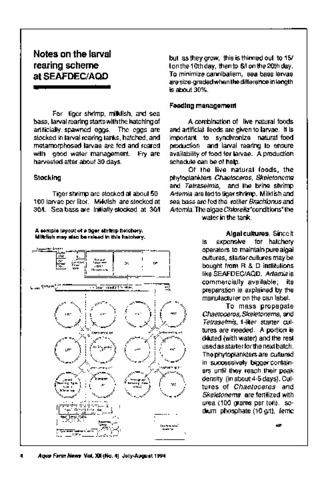Mycoflora of the 'green water' culture system of tiger shrimp Penaeus monodon Fabricius
Share
Abstract
This study was conducted to quantify and characterize the mycoflora associated with the ‘green water’ culture system of Penaeus monodon. Samples of water, tilapia gut and mucus, and shrimp hepatopancreas from three shrimp farms were collected during 15, 30, 45 and 60 days of culture (DOC). Results showed that high fungal loads were observed in tilapia gut (total: 117–1352 colony forming unit (CFU) 5 cm hind gut−1; yeasts: 0–136 CFU 5 cm hind gut−1) and mucus (total: 12–311 CFU (5 cm2)−1; yeasts: 0–88 CFU (5 cm2)−1), while minimal fungal populations were observed in water samples (total: 0–110CFU mL−1; yeasts: 0–5 CFU ml−1). Shrimp hepatopancreas harboured a very low number of filamentous fungi (0–27 CFU 0.1 g−1) and yeasts (0–7CFU 0.1 g−1) especially at 60 DOC. The filamentous fungal isolates were dominated by Penicillium and Aspergillus species, while the yeast populations were dominated by Rhodotorula and Saccharomyces species. The dominance of these fungi on tilapia mucus and gut and their presence in the rearing water might play an important role in the overall mechanisms involved in the control of luminous Vibrio in the ‘green water’ grow-out culture of P. monodon.
Suggested Citation
Leaño, E. M., Lio-Po, G. D., Nadong, L. A., Tirado, A. C., Sadaba, R. B., & Guanzon, N. G. (2005). Mycoflora of the 'green water' culture system of tiger shrimp Penaeus monodon Fabricius. Aquaculture Research , 36(16), 1581-1587. https://doi.org/10.1111/j.1365-2109.2005.01381.x
Subject
biological control; yeasts; dominant species; pathogenic bacteria; shrimp culture; Fungi; mucus; water analysis; aquaculture techniques; hepatopancreas; colonies; farms; digestive system; dissolved organic carbon; mycoflora; dominance hierarchies; Rhodotorula; Penaeus monodon; Vibrio; Saccharomyces; Penicillium; Aspergillus; tilapia
Taxonomic term
Collections
- AQD Journal Articles [1249]
Related items
Showing items related by title, author, creator and subject.
-
The growth, survival and production of shrimp (Penaeus monodon) cultured with green mussel (Perna viridis) in semi-intensive ponds
Corre, Kaylin G.; Corre, Valeriano L.; Gallardo, Wenresti (University of Philippines in the Visayas, 1997)The culture of tiger shrimps (Penaeus monodon) with and without green mussels (Perna viridis) was compared in terms of animal growth, survival, production, and pond water quality. Tiger shrimps (2.6 g) were stocked at ... -
Field efficacy evaluation of a formalin-inactivated white spot syndrome virus (WSSV) vaccine for the preventive management of WSSV infection in shrimp grow-out ponds
Amar, Edgar; Faisan, Joseph P., Jr.; Gapasin, Rolando S. J. (Elsevier, 2021)A shrimp grow-out trial was conducted in four 700 m2 earthen ponds in Dumangas Brackishwater Station of SEAFDEC Aquaculture Department, in Iloilo, Philippines to evaluate the efficacy of a combination of immersion- ... -
Notes on the larval rearing scheme at SEAFDEC/AQD
Castaños, Milagros T.; Southeast Asian Fisheries Development Center, Aquaculture Department (Aquaculture Department, Southeast Asian Fisheries Development Center, 1994)




